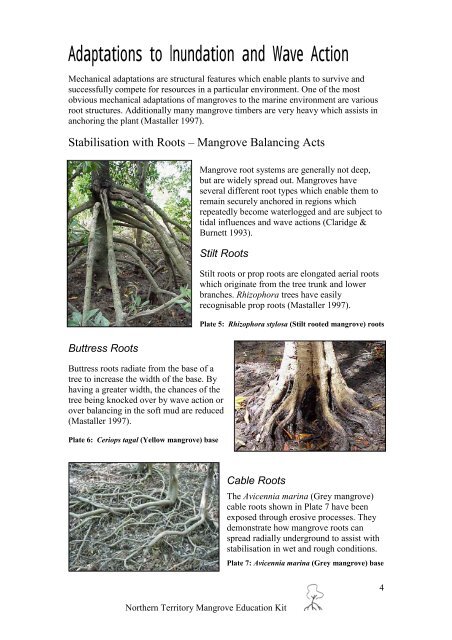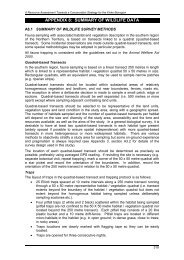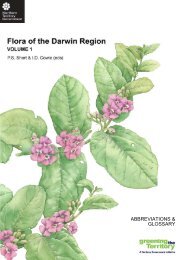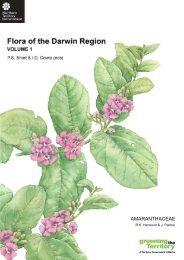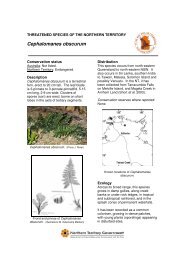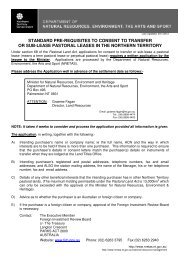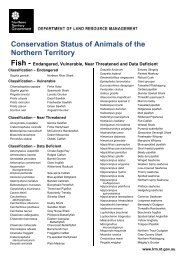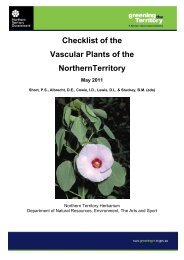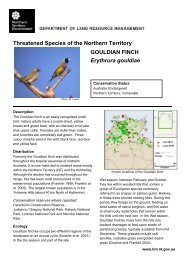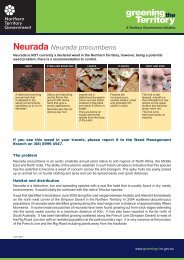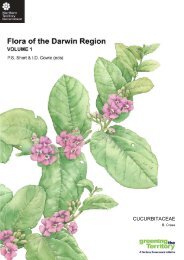Mangroves in the Northern Territory - Department of Land Resource ...
Mangroves in the Northern Territory - Department of Land Resource ...
Mangroves in the Northern Territory - Department of Land Resource ...
Create successful ePaper yourself
Turn your PDF publications into a flip-book with our unique Google optimized e-Paper software.
Adaptations to lnundation and Wave Action<br />
Mechanical adaptations are structural features which enable plants to survive and<br />
successfully compete for resources <strong>in</strong> a particular environment. One <strong>of</strong> <strong>the</strong> most<br />
obvious mechanical adaptations <strong>of</strong> mangroves to <strong>the</strong> mar<strong>in</strong>e environment are various<br />
root structures. Additionally many mangrove timbers are very heavy which assists <strong>in</strong><br />
anchor<strong>in</strong>g <strong>the</strong> plant (Mastaller 1997).<br />
Stabilisation with Roots – Mangrove Balanc<strong>in</strong>g Acts<br />
Buttress Roots<br />
Mangrove root systems are generally not deep,<br />
but are widely spread out. <strong>Mangroves</strong> have<br />
several different root types which enable <strong>the</strong>m to<br />
rema<strong>in</strong> securely anchored <strong>in</strong> regions which<br />
repeatedly become waterlogged and are subject to<br />
tidal <strong>in</strong>fluences and wave actions (Claridge &<br />
Burnett 1993).<br />
Stilt Roots<br />
Buttress roots radiate from <strong>the</strong> base <strong>of</strong> a<br />
tree to <strong>in</strong>crease <strong>the</strong> width <strong>of</strong> <strong>the</strong> base. By<br />
hav<strong>in</strong>g a greater width, <strong>the</strong> chances <strong>of</strong> <strong>the</strong><br />
tree be<strong>in</strong>g knocked over by wave action or<br />
over balanc<strong>in</strong>g <strong>in</strong> <strong>the</strong> s<strong>of</strong>t mud are reduced<br />
(Mastaller 1997).<br />
Plate 6: Ceriops tagal (Yellow mangrove) base<br />
Stilt roots or prop roots are elongated aerial roots<br />
which orig<strong>in</strong>ate from <strong>the</strong> tree trunk and lower<br />
branches. Rhizophora trees have easily<br />
recognisable prop roots (Mastaller 1997).<br />
Plate 5: Rhizophora stylosa (Stilt rooted mangrove) roots<br />
Cable Roots<br />
Nor<strong>the</strong>rn <strong>Territory</strong> Mangrove Education Kit<br />
The Avicennia mar<strong>in</strong>a (Grey mangrove)<br />
cable roots shown <strong>in</strong> Plate 7 have been<br />
exposed through erosive processes. They<br />
demonstrate how mangrove roots can<br />
spread radially underground to assist with<br />
stabilisation <strong>in</strong> wet and rough conditions.<br />
Plate 7: Avicennia mar<strong>in</strong>a (Grey mangrove) base<br />
4


